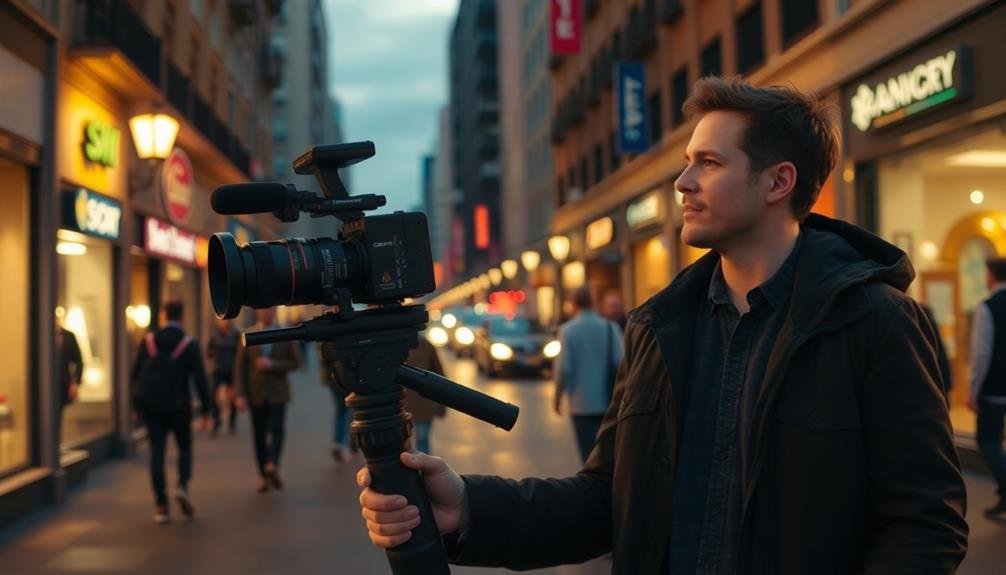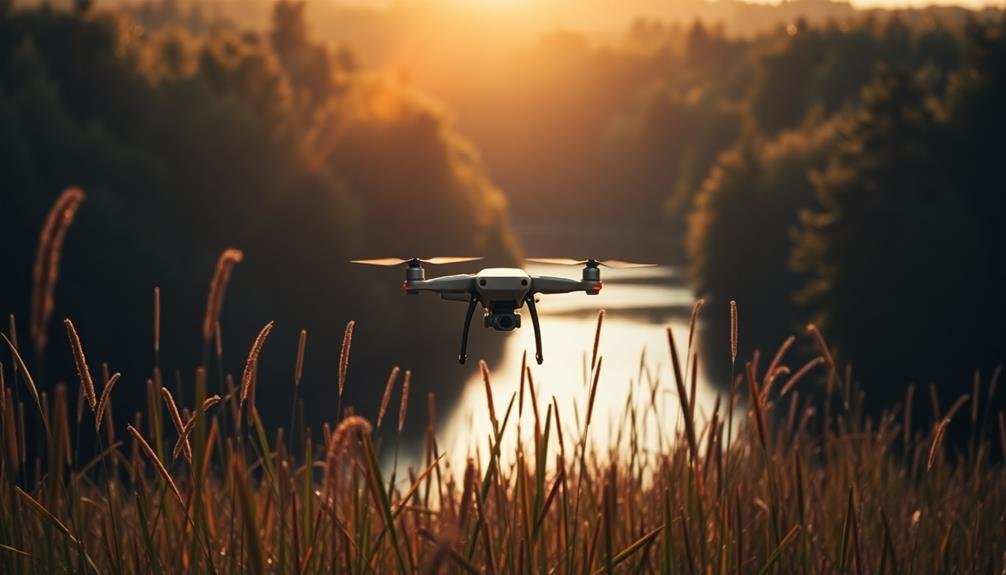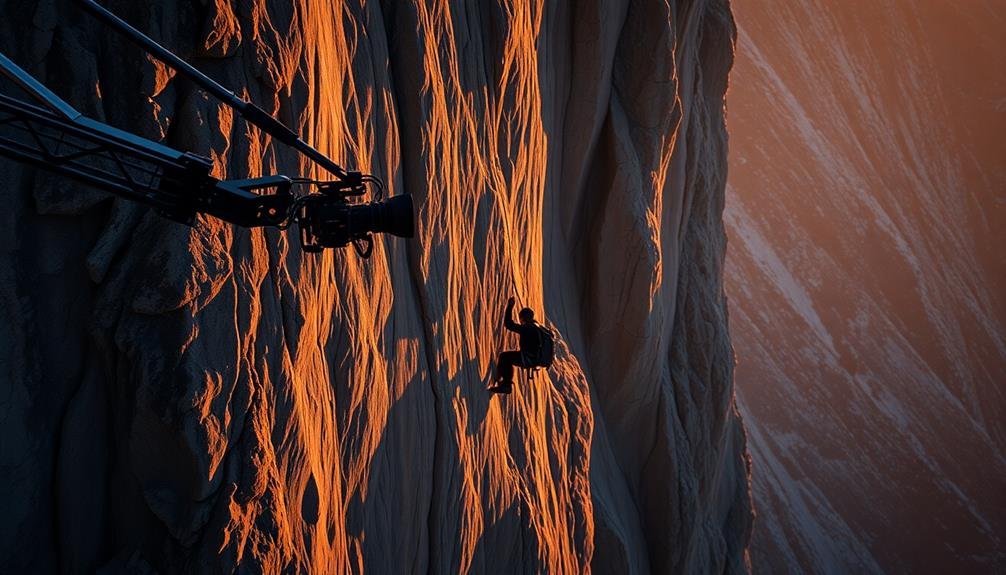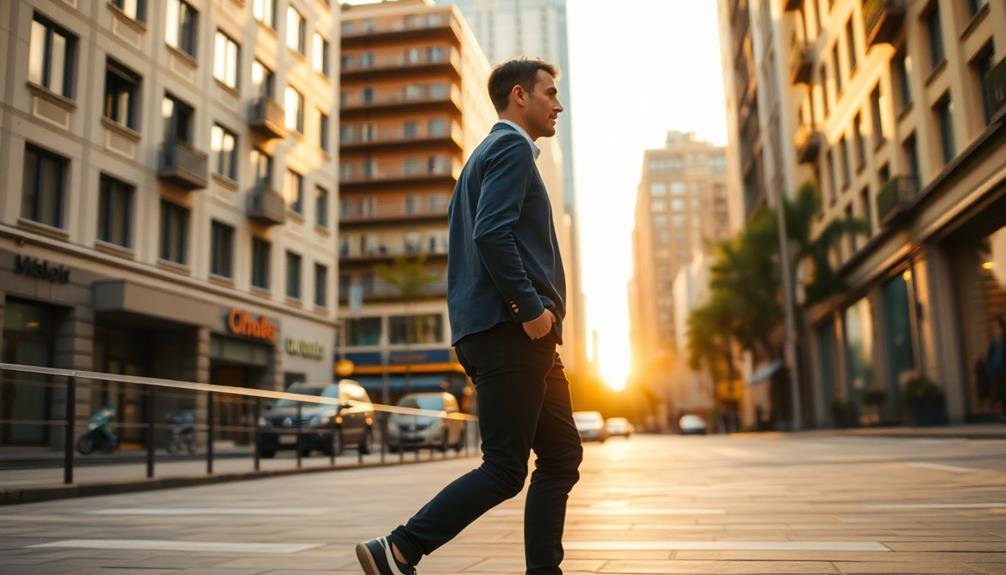To capture cinematic footage, master these five follow shot techniques. Use smooth tracking shots for fluid motion, employing stabilizers like gimbals. Create visual interest with orbit follows, circling your subject. Try low altitude reveals to build anticipation, starting low and gradually increasing height. Add excitement through dynamic elevation changes, altering drone altitude during shots. Finally, use parallax follow shots to enhance depth by revealing multiple scene layers. Each technique requires practice and careful planning, but they'll elevate your footage from amateur to professional. Discover how these methods can transform your storytelling and captivate your audience.
Smooth Tracking Shot

The smooth tracking shot is a cornerstone of cinematic follow shots. It's a technique that creates fluid motion, allowing you to follow your subject seamlessly through a scene. To achieve this, you'll need a stabilizing device like a gimbal, dolly, or steadicam.
Start by planning your shot. Map out the subject's path and identify potential obstacles. Practice the movement before filming to guarantee smooth operation. When shooting, keep your movements slow and steady. Maintain a consistent distance from your subject, adjusting your speed to match theirs.
Focus on your body positioning. Keep your knees slightly bent and your core engaged for better stability. Use your feet to guide the movement, taking small, even steps. If using a handheld gimbal, keep your arms close to your body for added control.
Pay attention to framing. Maintain proper headroom and lead room as your subject moves. Anticipate changes in direction and adjust accordingly. Use wider lenses to minimize shake and increase your depth of field.
Orbit Follow
Circling your subject, the orbit follow shot adds dynamic movement and visual interest to your footage. This technique involves moving the camera in a circular path around your subject while keeping them centered in the frame. To execute an orbit follow, you'll need to maintain a consistent distance from your subject as you move.
Start by identifying a clear path around your subject, free of obstacles. Use a stabilizer or gimbal to guarantee smooth movement. Begin your shot and move steadily, keeping your eyes on the subject and adjusting your framing as needed. Practice maintaining a constant speed to avoid jarring shifts.
For added impact, try varying your height as you orbit. Start low and gradually rise, or begin high and descend as you circle. You can also experiment with different focal lengths – wide-angle lenses emphasize the background movement, while telephoto lenses compress the scene and focus on the subject.
Orbit follows work well for revealing locations, showcasing products, or adding drama to character introductions. They're particularly effective in outdoor settings or spacious interiors where you have room to maneuver.
Low Altitude Reveal

Cinematographers looking to add a sense of anticipation and grandeur to their footage should consider the low altitude disclosure technique. This method involves flying your camera low to the ground, often just above obstacles, before slowly ascending to disclose a breathtaking landscape or subject. It's a powerful way to create tension and then release it with a stunning visual payoff.
To execute a low altitude disclosure, you'll need a drone or a stabilized camera rig. Start by positioning your camera close to the ground, perhaps behind foliage or rocks. As you begin moving forward, gradually increase altitude. The key is to maintain a smooth, steady ascent that builds anticipation. Time your disclosure to coincide with the climax of your shot, whether it's a majestic mountain range or a sprawling cityscape.
Here's what you might capture with a low altitude disclosure:
- A dense forest canopy giving way to a hidden waterfall
- Tall grass parting to expose a herd of wild animals
- Urban rooftops rising to showcase a towering skyscraper
- Sandy dunes revealing a vast desert oasis
- Rocky terrain opening up to a panoramic canyon view
Remember to practice your timing and camera movements to achieve the most impactful disclosure possible.
Dynamic Elevation Change

While low altitude reveals captivate audiences with anticipation, dynamic elevation changes offer a different kind of visual excitement. This technique involves smoothly altering your drone's altitude during a follow shot, creating a sense of depth and perspective.
To execute a dynamic elevation change, you'll need to master simultaneous control of your drone's forward movement and altitude. Start by choosing your subject and flight path. As you follow your subject, gradually increase or decrease altitude to reveal new elements in the frame.
Here's a quick guide to dynamic elevation changes:
| Elevation Change | Effect | Best Used For |
|---|---|---|
| Ascending | Reveals landscape | Scenic shots, establishing |
| Descending | Focuses on subject | Character introductions |
| Alternating | Creates visual rhythm | Action sequences |
| Rapid | Adds drama and urgency | Climactic moments |
| Slow | Builds tension gradually | Emotional scenes |
Remember to keep your movements smooth and deliberate. Practice your timing and pacing to guarantee the elevation change complements your subject's movement. By mastering this technique, you'll add a powerful tool to your cinematic arsenal, creating dynamic and engaging follow shots that captivate your audience.
Parallax Follow Shot

A parallax follow shot adds depth and dimensionality to your footage by revealing multiple layers of the scene. To achieve this effect, you'll need to move the camera laterally while following your subject. As you track the subject, foreground elements will move faster across the frame than background elements, creating a dynamic sense of space and movement.
To execute a parallax follow shot effectively, choose a location with distinct foreground, midground, and background elements. Move your camera smoothly and steadily, maintaining focus on your subject throughout the shot. You can use a slider, dolly, or even a handheld setup for more organic movement.
Here's what you might see in a well-executed parallax follow shot:
- Foreground objects quickly sliding out of frame
- Your subject moving at a moderate pace
- Background elements shifting slowly
- Layers of depth becoming apparent
- New elements revealed as you move
Experiment with different speeds and distances to find the right balance between subject tracking and parallax effect. Remember, the goal is to enhance your storytelling by immersing the viewer in a three-dimensional space.
With practice, you'll master this technique and create visually striking footage that elevates your cinematic work.
Frequently Asked Questions
How Do Weather Conditions Affect Follow Shot Techniques?
Weather greatly impacts your follow shots. Wind can destabilize your camera, rain affects visibility, and harsh sunlight creates contrast issues. You'll need to adapt your techniques, adjust settings, and use protective gear to maintain smooth, cinematic footage.
What's the Best Camera Stabilization Equipment for Follow Shots on a Budget?
You'll get great results with a handheld gimbal stabilizer. It's affordable and versatile for follow shots. If you're on a tighter budget, try a shoulder rig or monopod. They're cost-effective options that'll improve your footage stability.
How Can I Practice Follow Shot Techniques Without Professional Actors?
You can practice follow shots without professional actors by using friends, family, or even pets. Try following their natural movements in various settings. You'll improve your technique by tracking everyday activities like walking, running, or playing sports.
Are There Specific Lenses Recommended for Achieving Cinematic Follow Shots?
You'll want to contemplate prime lenses like 35mm or 50mm for follow shots. They're great for capturing cinematic depth and bokeh. Don't forget wide-angle lenses (24mm or 28mm) for broader scenes with more context.
How Do I Maintain Focus During Fast-Paced Follow Shots?
You'll want to use autofocus or practice manual focusing. Keep your subject in the frame's center, use a wider aperture, and maintain a consistent distance. Pre-focus on key points if possible, and consider using focus peaking.
In Summary
You've now mastered five powerful follow shot techniques to elevate your cinematic footage. Whether you're smoothly tracking your subject, orbiting for dramatic effect, revealing with a low-altitude approach, changing elevation dynamically, or creating depth with parallax, you're equipped to capture stunning visuals. Don't be afraid to experiment and combine these methods. With practice, you'll develop an intuitive sense for when to use each technique. Now go out there and create some breathtaking shots!

As educators and advocates for responsible drone use, we’re committed to sharing our knowledge and expertise with aspiring aerial photographers.




Leave a Reply